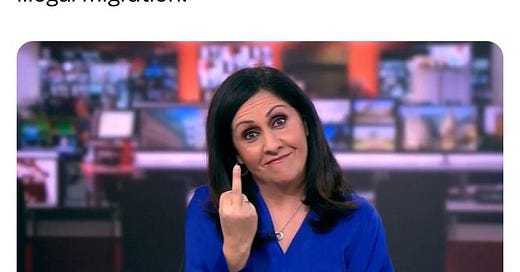On Wednesday, BBC news presenter Maryam Moshiri stuck her middle finger up at the camera while an intro was playing and failed to take it down quickly enough to avoid being seen on air. It was quite funny. By Thursday morning, clips of the incident were being shared widely on social media, because of course they were.
On Thursday afternoon, the Conservative Party tweeted the image from their official account.
People noticed. It is impossible for the Conservatives to tweet anything without creating a hostile reaction from the kinds of people who think replying to tweets is a good use of their time, so we shouldn’t read too much into the fact that this tweet did that. But it clearly created mixed feelings even inside the Conservative Party, with opinions ranging from that of Jonathan Gullis, who tweeted “I approve this message” to Tobias Ellwood, Gavin Barwell and Alicia Kearns who said it should have been taken down.
That created “Tories divided” headlines, although to be fair these were a distraction from other “Tories divided” headlines. Unnamed Tory MPs were quoted as saying “I’m lost for words. This is gutter politics” and “Colleagues are furious”.
Stephen Bush of the Financial Times, who generously recommended this Substack and less generously commissioned this piece all in the same tweet, gave his view on the matter as “everything a political party does needs to be big and unsubtle to be noticed and some of it should cause people to go ‘that’s a bit much, isn’t it?’ If this post is bad, it’s because it is leading with the party’s glass jaw on migration, not cos it is crude”.
It is crude, and it does lead with the party’s glass jaw, neither of which is ideal. And given the nature of arguments about the topic, and the dark places some people on the right want to go with them, I find the optics of using a visibly ethnic minority woman giving the finger as a metaphor for Labour’s attitude to immigration a bit hair-raising, but I’m willing to accept that the problem here is that they underthought it (and that I overthought it) rather than that they were actively trying to do a dog-whistle. The fact that Maryam Moshiri is wearing a blue dress gets in the way of the Tories’ message too, in the opposite direction, because it’s too easy to read a woman in this kind of blue dress as a Tory. The reason for these inconvenient imperfections is that the image isn’t perfectly constructed to fit the message: it was just topical on the day. You can’t construct your own memes with actors; you have to work with the material you’re given. Let’s give the Tories some leeway on all that. I think it’s likely that, broadly speaking, they went into this row with their eyes open: they sought to be provocative, and they did indeed provoke, albeit mostly their own MPs.
On one level, this is reminiscent of the argument earlier this year about Labour’s Twitter graphic claiming that Rishi Sunak doesn’t think that adults convicted of sexually assaulting children should go to prison.
You have the outrage, the complaints from people on the same side, the news coverage, the consequent amplification of the original attack. But there’s an important structural difference in the way the controversy plays out from the initial point of provocation, and it stems from what precisely it is that people are objecting to.
With the Labour graphic, the controversy was “Is it legitimate to claim that Rishi Sunak doesn’t think sex offenders should be locked up?” The substantive argument is at the heart of the story and you can’t take part in it without getting into the question, even if you think the answer is no. You have to explain why the answer is no. On one level, it’s the same idea as the old story about one of Lyndon Johnson’s Texan campaigns:
The race was close and Johnson was getting worried. Finally he told his campaign manager to start a massive rumor campaign about his opponent’s life-long habit of enjoying carnal knowledge of his own barnyard sows.
“Christ, we can’t get a way with calling him a pig-fucker,” the campaign manager protested. “Nobody’s going to believe a thing like that.”
“I know,” Johnson replied. “But let’s make the sonofabitch deny it.”1
Labour’s ad was, in my view, more defensible than that: it isn’t completely made up, but it relies on the very contestable idea that once a party has been in power for some time, the long-term problems it doesn’t deal with are political choices that can be pinned on them even if they are not its explicit intentions. I thought it was more trouble than it was worth and I wouldn’t have run it myself, but I didn’t mind defending it in my occasional role as D-list Labour partisan political commentator in the media, as in this clip of me on LBC slightly incredulously denying that the use of Rishi Sunak’s signature was an attempt to dupe the public into thinking it was a Tory ad.2
With the Tory middle-finger tweet, the substance of the attack is separate from the row about the graphic. You can debate whether the Tories are right or wrong to use a vulgar image, without even knowing that the argument being made here is about whether Labour has an immigration policy - the medium is too far removed from the message. There is no political row about the message, which means that the message doesn’t get amplified. The senior Tory figures objecting to the tweet do not, so far as I can see, have any problem in principle with the claim that Labour has no alternative to the Rwanda plan, and they would be quite content to see the attack expressed in different terms. It’s just the middle finger they don’t like. The trouble is that the attack doesn’t work however you express it.
A few weeks ago I wrote about parties deliberately putting out bad material on social media so that people would share it widely, intending to make fun of it but in the process spreading the party’s central strategic message to a wider audience. There’s a bit of that going on here: certainly a lot of the dissemination of the tweet has been through hate-sharing. The problem is this: this is not the Conservatives’ central strategic message. It’s a desperate defensive one, on an issue where their central strategic message has fallen apart. They want their message to be: we are stopping the boats. But they are not stopping the boats. They want their message to be: we have a plan. But they do not have a plan. They want their message to be: we are united behind a policy that will work. But they are disunited behind a policy that will not work. The most vocal critics of their current position were literally Home Office ministers weeks or even days ago. It’s a terrible place to be, and the question of whether Labour has an effective alternative is beside the point, however much they want it to be the point.
The Conservatives would love the immigration dividing line to be plan/no plan, competence/incompetence, unity/division. That’s the line this tweet is trying to amplify. But that ship has sailed. No wonder they’re all sticking their fingers up at each other.
Hard to imagine a contemporary British politician denying allegations of having sexual relations with a pig, isn’t it?
Since I started this Substack and encouraged people to make suggestions about things to write about a couple of people have said I should write about this controversial ad. The main reason I haven’t until now is that I’ve generally tried to use new news as the hook, and this is several months old. So here you go, and this is probably all you’re getting, but I genuinely appreciate the requests and feedback.







I still think the Labour one was really grim and basically indefensible, but also strategically dumb. There is something central to Labour’s image, or least self-image, that they are somehow “better” than the Tories. That ad put a big dent in that and suggested they are just another political party that will say anything, even to the extent to exploiting child abuse, to score a cheap point.